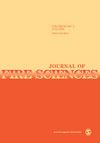Electrical applications in Internet of things and e-vehicles: Passive fire safety needs and solutions
IF 1.9
4区 工程技术
Q2 ENGINEERING, MULTIDISCIPLINARY
引用次数: 0
Abstract
The exponential growth of electrical devices in Internet of things and e-vehicles will lead to new fire safety challenges. As electric fires rank second among all fires and electrical equipment recalls show safety gaps, fire safety requirements must be better enforced and improved. The analysis of the current qualitative pass/fail requirements for electrotechnical products shows that they provide a basic level of fire safety. Fire testing of car and bus interiors, mandatory worldwide, is too low level. Alternative tests, such as the microscale combustion calorimeter, are discussed. Buses have to comply with additional fire tests. E-vehicles must meet a fire exposure test for electric powertrain and specifications to prevent thermal runaway of batteries. Charging stations must comply with fire and overheating requirements for enclosures, plugs, and sockets. Passive fire safety needs are primarily met by using flame retardants, and for preventing thermal runaway of batteries, by intumescent coatings, interlayers, and ceramifying products.物联网和电动汽车中的电气应用:被动消防安全需求和解决方案
物联网和电动汽车中电气设备的指数级增长将带来新的消防安全挑战。由于电气火灾在所有火灾中排名第二,电气设备召回显示出安全漏洞,必须更好地执行和改进消防安全要求。对目前电工产品质量合格/不合格要求的分析表明,它们提供了基本的消防安全水平。汽车和公共汽车内饰的防火测试在世界范围内是强制性的,但水平太低。讨论了替代试验,如微尺度燃烧量热计。公共汽车必须遵守额外的防火测试。电动汽车必须通过电动动力系统的火灾暴露测试和防止电池热失控的规范。充电站必须符合外壳、插头和插座的防火和过热要求。被动防火安全需求主要通过使用阻燃剂来满足,并通过膨胀涂层、中间层和陶瓷化产品来防止电池的热失控。
本文章由计算机程序翻译,如有差异,请以英文原文为准。
求助全文
约1分钟内获得全文
求助全文
来源期刊

Journal of Fire Sciences
工程技术-材料科学:综合
CiteScore
4.00
自引率
0.00%
发文量
14
审稿时长
2.5 months
期刊介绍:
The Journal of Fire Sciences is a leading journal for the reporting of significant fundamental and applied research that brings understanding of fire chemistry and fire physics to fire safety. Its content is aimed toward the prevention and mitigation of the adverse effects of fires involving combustible materials, as well as development of new tools to better address fire safety needs. The Journal of Fire Sciences covers experimental or theoretical studies of fire initiation and growth, flame retardant chemistry, fire physics relative to material behavior, fire containment, fire threat to people and the environment and fire safety engineering. This journal is a member of the Committee on Publication Ethics (COPE).
 求助内容:
求助内容: 应助结果提醒方式:
应助结果提醒方式:


